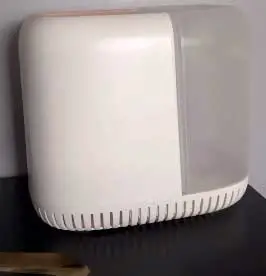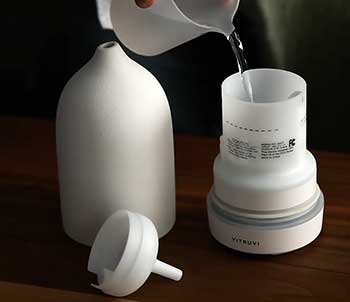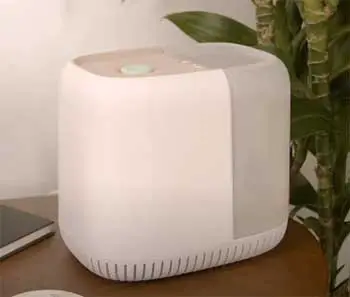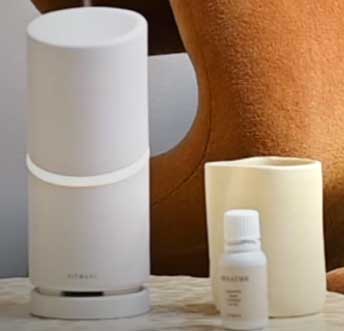Humidifiers have become an increasingly popular home appliance for adding much-needed moisture to dry indoor air. But with so many models on the market, it can be tough to decide which humidifier is right for your needs. Two popular options are the Canopy humidifier and Vitruvi diffuser.
But what exactly is the difference between these two devices? And which one is better suited for your home?
In this comprehensive guide, we’ll compare and contrast the key features of Canopy and Vitruvi humidifiers. We’ll look at things like humidifying technology, tank capacity, runtime, special features, design, ease of use, and price.
We’ll also provide a handy comparison chart so you can see the specs side-by-side. Read on to find out which humidifier comes out on top!
A Brief Comparison Table
| Feature | Canopy Humidifier | Vitruvi Diffuser |
| Type of Humidifier | Cool mist | Ultrasonic cool mist |
| Tank Capacity | 1 gallon | 0.5 gallon |
| Runtime per Tank | 36 hours | 7 hours |
| Coverage Area | 500 sq ft | 750 sq ft |
| Humidistat | Yes | No |
| Essential Oil Tray | No | Yes |
| Night Light | No | Yes |
| Auto Shutoff | Yes | Yes |
| Dimensions | 8.5 x 8.5 x 13.5 in | 6 x 5 x 10 in |
| Weight | 5 lbs | 2.65 lbs |
| Warranty | 2 years | 1 year |
| Price | $199 | $159 |
Key Differences Between Canopy And Vitruvi Humidifiers
- Humidifying Technology

The first difference between the Canopy and Vitruvi is the humidifying technology they use.
The Canopy uses cool mist technology. This means it uses a fan to blow air through a wick filter.
The passing air absorbs water from the wick, which then exits the humidifier as a cool, invisible mist.
Cool mist humidifiers are known to be very quiet.
The Vitruvi, on the other hand, uses ultrasonic technology. This means it vibrates a metal diaphragm at a high ultrasonic frequency.
This vibration breaks down the water into a micro-fine cool mist. Ultrasonic models are also quiet, but may make more of a subtle buzzing sound.
Both cool mist and ultrasonic humidifiers effectively increase moisture levels in the air without producing hot steam. Ultrasonic models tend to humidify larger spaces more quickly, but may require using distilled water to prevent white dust.
- Tank Capacity and Runtime
Another big difference between the Canopy and Vitruvi is tank capacity and runtime.
The Canopy has a 1 gallon tank, which allows it to run for up to 36 hours on a single fill. This large capacity is handy since you won’t have to refill the tank daily.
Comparatively, the Vitruvi only holds 0.5 gallons of water. This smaller tank allows for a runtime of about 7 hours. So you’ll need to refill this humidifier more frequently.
If you want a humidifier that can run overnight or while you’re at work without needing a refill, the Canopy’s larger tank makes it more convenient. Frequent travelers may also prefer the longer runtime.
- Humidistat

The Canopy humidifier has a built-in humidistat, whereas the Vitruvi does not.
A humidistat is a sensor that measures relative humidity levels in the room.
You can set your desired humidity level on the Canopy, and the humidistat will automatically adjust the mist output to maintain that level.
The Vitruvi lacks this auto-regulating feature. Without a humidistat, you manually control the mist output.
So you’ll have to adjust it yourself based on changes in humidity.
If maintaining a specific humidity level is important to you, the Canopy’s humidistat offers more precise automated control.
- Coverage Area
While the Vitruvi has a smaller tank capacity, it can actually humidify larger spaces than the Canopy.
The Vitruvi can provide moisturizing mist to rooms up to 750 square feet. So it’s a great option for large open concept rooms, studios, and offices.
The Canopy has a coverage area of 500 square feet. It’s better suited to medium-sized rooms like bedrooms, nurseries, and home offices.
So if you need a humidifier to tackle a larger open area, the Vitruvi is the way to go. But for a single room, the Canopy also works great.
- Special Features
There are also some unique extra features to note in each model:
- The Vitruvi has an essential oil tray so you can add your favorite scents. The mist will diffuse the aroma throughout the room.
- It also has a soft night light you can turn on for a soothing glow.
- The Canopy lacks these features, but stands out for its large 1 gallon tank and built-in humidistat.
So if aromatherapy and ambiance are important to you, the Vitruvi’s extras create a more relaxing experience. But the Canopy offers unbeatable runtime and precise humidistat control.
- Design

In terms of design, the Vitruvi has a sleek, modern look with a porcelain exterior available in white, black, blue, pink and green.
It’s compact and lightweight making it easy to move room to room.
The Canopy has a more classic shape reminiscent of vintage humidifiers.
It has a neutral beige plastic casing. While not as trendy looking as the Vitruvi, it won’t clash with most decors.
Both models are fairly compact in size. But the Canopy is about 3 inches taller, making it less suited to smaller nightstands.
So if you want a humidifier that doubles as a chic home accessory, the Vitruvi is very stylish. But the Canopy has a simpler, fuss-free design.
- Ease of Use
When it comes to ease of use, both humidifiers are designed to be user-friendly and low maintenance.
Filling the tanks is simple – just remove from the base and fill with water in your sink. The tank openings are wide enough for easy refilling.
Maintenance involves regular cleaning to prevent mold and bacteria buildup. Both companies recommend cleaning every 1-2 weeks, which involves disinfecting the tanks with a vinegar solution.
The Vitruvi’s smaller tank makes cleaning a bit simpler compared to the larger Canopy. But both only take about 5-10 minutes to clean.
Emptying excess water from the tanks is also easy with the drain plugs or valves built into the bases.
Overall, the Canopy and Vitruvi are very similar when it comes to convenience of use. As long as you clean them regularly, they are straightforward to operate and maintain.
Also Read: Comparison of CarePod And Canopy Humidifiers.
- Cost Comparison

When it comes to price, the Vitruvi is the more budget-friendly option.
It costs $159 on average.
The Canopy costs $199, so it’s about $40 more expensive.
For the extra $40, the Canopy offers a larger tank capacity, longer runtime, humidistat, and 2 year warranty.
So it may be worth the higher price for some buyers.
But if you want to spend less upfront, the Vitruvi still offers solid performance for smaller spaces without all the bells and whistles.
- Warranty
The warranty coverage also differs between the two models:
- The Canopy comes with a 2 year warranty.
- The Vitruvi warranty lasts for 1 year.
So the Canopy again provides longer coverage should anything go wrong with the humidifier.
For some buyers, the peace of mind of a 2 year warranty makes the higher price tag worthwhile. But Vitruvi’s 1 year coverage is still decent for a humidifier in this price range.
And The Winner Is…
Based on this Canopy vs Vitruvi comparison, the Canopy humidifier narrowly edges out the Vitruvi overall thanks to:
- Its large 1 gallon tank and runtime of 36 hours per fill
- Built-in humidistat for automated humidity control
- 2 year warranty providing longer coverage
However, the Vitruvi is a great choice if:
- You need to humidify a large open room up to 750 sq ft
- You want to use essential oils and take advantage of the night light
- Your budget is under $160
Both humidifiers are quiet, efficient, and easy to use. The Canopy suits bedrooms and medium rooms, while the Vitruvi tackles large living areas. And they produce the same healthy cool mist.
So consider whether tank capacity, special features, or price matter most to you. And let your specific needs guide you towards the best humidifier for your home.
Whichever model you choose, Canopy or Vitru vi, you can enjoy the benefits of properly humidified air.
Also Read: Comparison of Miro And Carepod Humidifiers.
Frequently Asked Questions (FAQ)
A humidifier adds moisture back into dry air to increase humidity levels in a room. A diffuser also humidifies, but its main purpose is to disperse essential oils. While models like the Vitruvi do both, standard humidifiers just focus on moisturizing the air.
Yes, the Vitruvi uses ultrasonic technology to effectively humidify rooms up to 750 square feet. Its 0.5 gallon tank allows it to run for up to 7 hours, releasing a micro-fine cool mist. So while it’s also an aromatherapy diffuser, it definitely works to add humidity to dry air.
Canopy is a brand that makes humidifiers, including the Canopy Cool Mist Humidifier compared in this article. It uses a wick filter and fan to produce a cool mist. Key features include its 1 gallon tank, runtime of 36 hours, built-in humidistat, and 2 year warranty. Canopy humidifiers are designed to automatically maintain ideal humidity levels.
Wrapping Up
No matter which device you choose, proper humidification can benefit everyone from babies to the elderly. The right humidity helps alleviate issues caused by dry air, like skin irritation, congestion, and cracked lips.
It also protects furniture and household items. So consider humidifying if your home’s air feels overly dry.
With this Canopy and Vitruvi comparison, you now have the knowledge to pick the best humidifier model for your specific home and family. Both companies make quality products that add much-needed moisture during dry seasons.
And you can rest easy knowing your investment is protected by a 1-2 year warranty. Just be diligent about regular cleanings.
Whichever humidifier you select, pay attention to any changes after using it for a few weeks. Notice if your sinuses feel less congested, skin becomes more supple, and other benefits.
With the right humidifier helping regulate moisture levels, you’ll be able to breathe easy and feel comfortable throughout your whole home.
